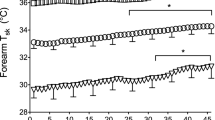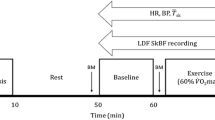Abstract
To examine the mechanisms and regional differences in the age-related decrement of skin blood flow, 11 young (age 20–25 years) and 10 older (age 64–76 years) men were exposed to a mild heat stress by immersing their feet and lower legs in water at 42°C for 60 min, while they were sitting in near thermoneutral conditions [25°C and 45% relative humidity (rh)]. During the equilibrium period (25°C and 45% rh) before the heat test, no group differences were observed in rectal (T re) and mean skin (T sk) temperatures or mean arterial pressure (MAP). During passive heating, T sk was significantly lower in the older men 20 min after commencing exposure (P < 0.001), although there were similar increases in T re in both groups. Exposure time and age did not affect MAP. The local sweating rate (m˙ sw) and the percentage change in skin blood flow by laser Doppler flowmetry (%LDF) relative to baseline values on the chest, back, forearm and thigh were significantly lower in the older men (P < 0.001), especially on the thigh. After starting the heat exposure, three temporal phases were observed in the relationship between %LDF and m˙ sw at most sites in each subject. In phase A, %LDF increased but with no increase in m˙ sw. In phase B, m˙ sw increased but with no secondary increase in %LDF. Finally, in phase C, there were proportional increases in %LDF and m˙ sw. The increase in %LDF in phase A was significantly lower on the forearm and thigh (P < 0.05) for the older men, but not on the chest and back. In phase C, the slopes of the regression lines between %LDF and m˙ sw were lower for the older men on the back (P < 0.03), forearm (P = 0.08) and thigh (P < 0.03), but not on the chest. These results would suggest that the age-related decrement in skin blood flow in response to passive heating may be due in part to a smaller release of vasoconstrictor tone and to less active vasodilatation once sweating begins. Regional differences exist in the impaired vasoconstriction and active vasodilatation systems.
Similar content being viewed by others
Author information
Authors and Affiliations
Additional information
Accepted: 29 May 1998
Rights and permissions
About this article
Cite this article
Inoue, Y., Shibasaki, M., Hirata, K. et al. Relationship between skin blood flow and sweating rate, and age related regional differences. Eur J Appl Physiol 79, 17–23 (1998). https://doi.org/10.1007/s004210050467
Issue Date:
DOI: https://doi.org/10.1007/s004210050467




